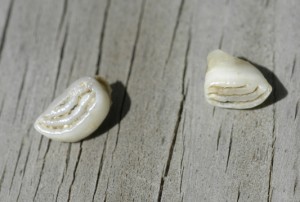Koi fish like to eat. Not much outside of chilly temperatures and ill health will keep them from a meal. As we have discussed before, thanks to an evolutionary path that has equipped them with extensive foraging capabilities, that includes almost anything that they can fit in their mouth.
But once they eat what happens to it?

Buccal Cavity
Complete with tiny bumps (or papillae) as well as a full array of taste buds and mucous-secreting goblet cells, the koi’s buccal cavity is adept at determining what should make its way through the digestive tract or not.
Once the food reaches the back of the throat, a koi has already decided if it doesn’t fit size or dietary requirements and is spit back out or pushed out through the gills. It is suggested that while foraging in a more natural setting, over 90% of what goes into a koi’s mouth comes back out without making the grade.
Teeth

Once the morsel has been deemed edible, the food heads to the back of the throat where the teeth go to work, fragmenting the larger and harder pieces. A koi’s teeth are not teeth in the sense that we know them, but rather are bony projections that grow from the bottom of the gill plates at the back of the throat. Older teeth can actually be replaced by newer ones.
By grinding some of the tougher foods it encounters against a hard cartilaginous area (or pad) at the skull’s base, the teeth are instrumental in breaking larger and harder substances into small enough pieces for easier movement down the digestive tract as well as better digestion.
Oesophagus
Once it is ready for digestion, the “chewed” food passes through the short (but wide) oesophagus. The oesophagus has its own bank of taste buds for a secondary checking mechanism to ensure that what moves back into the intestine has the right ingredients. It is also lined with goblet cells and cilia to move food into the next stage of digestion—the intestines.
Intestines
Koi fish do not have stomachs. As a result, their intestines (or “gut”) serve the purpose of preparing food for nutrient absorption. The intestines of a koi fish are not particularly complex and can an be upwards of 2-3 times longer than an adult koi. The longer and folded track allows the time necessary to for fibrous materials (like plants and vegetation) to be fully digested.
Once the intestinal opening is stretched, the peristalsis—or wave motion—is stimulated and the process of shunting food down the line is continued.
The intestines are lined with more goblet cells (secreting mucous for lubrication as well as protection) and cilia (which increase the surface area for more efficient absorption) to keep the food moving along in a smooth and uniform fashion.
Without a stomach, there is also no acidic treatment, so a koi’s more alkali tract utilizes enzymes to aid in creating usable nutrients. Some of the enzymes are created in the intestines itself while the bulk come from the pancreas. Additionally, the intestines is also home to range of natural bacteria that help with digestion and absorption.
Pancreas
Enzymes (or the “digestive juices”) are produced here in abundance and passed into the intestines through a duct. Although the intestinal lining does produce some digestive enzymes, the majority comes from the pancreas (which are located throughout the liver)
Liver
This is an important organ in terms of nutrient creation and storage within the koi’s digestive process. For one, it produces the bile that aids in proper digestion. The liver acts a storage warehouse, holding the raw glycogen that will then be used to create glucose and a ready source of energy for the koi.
Anal Pore
As the name suggests, this is the last port of call for whatever is left over once the koi has absorbed as many of the nutrients it needs or is able to. Through here all the waste matter is excreted.
Next Day Koi has a vast selection of koi fish for sale, sourced from some of the best farms around the world. To ensure the health of our koi, and that you receive the best koi possible, we quarantine and closely monitor new arrivals for two weeks.
Coupled with a great selection of both sizes and types, we leverage our high volume of shipping through UPS to bring you some of the most competitive Next Day Air shipping rates in the industry.

[…] Quote from the source: … […]